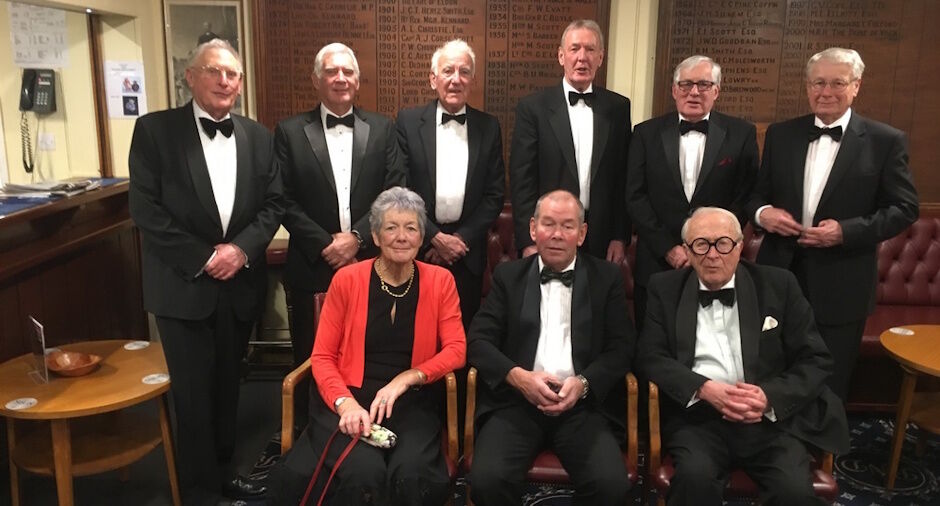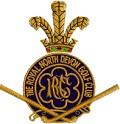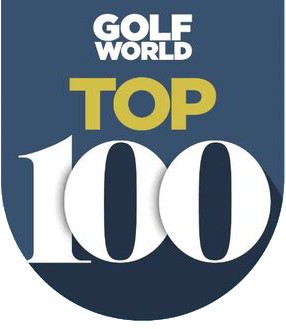History of Royal North Devon Golf Club
The oldest Links Course in England
Royal North Devon at Westward Ho! can rightly claim to be the cradle of English Golf. Founded in 1864, it is the oldest golf course in the country and is regarded as the St Andrews of the South. The golf course is as tough as any of the UK’s more famous links layouts and has recently been placed in Golf World 's "Top 100 Courses in the World" that a golfer “must play”.

Not only is Royal North Devon a great course, it is also a place of huge historical importance. Inside the warmly welcoming clubhouse, the golf museum, honours boards and the clubs top competition trophies are worth a visit on their own and help to tell the story of the game and this remarkable club’s unique place in it.
Above all, this is great, natural golf that is largely unchanged from 100 years ago when Harold Hilton et al pronounced Westward Ho! As England’s No 1 competition golf course. RND is pure, raw exhilaration and ultimately the experience of playing a fast running links in a stiff breeze still tests the very best in the game.
Video Interview:
‘The Long Golden Afternoon: Golf’s Age of Glory, 1864-1914’
To mark the 160th anniversary of Royal North Devon Golf Club, Stephen Proctor, author of ‘The Long Golden Afternoon: Golf’s Age of Glory, 1864-1914’, talks to RND member Dan Davies about the club’s early history and the pivotal role it played in the birth of English golf.
The Cradle of English Golf
By Dan Davies (Club member)
Savour that first glimpse as you exit Northam Square because it is a view that has stirred the senses of golfers for more than 170 years. And yet the vast patchwork of greens and browns that stretches out under huge skies to a pebble ridge, golden sands and the white horses of Bideford Bay beyond betrays no hint that on this 600-acre parcel of common land called Northam Burrows is a golf course, let alone one so steeped in history that it’s known as ‘The Cradle of English Golf’.
Golf has been played here since the 1850s and for this we can thank one Reverend Isaac Gosset, the founder of the very first school of English golf. The Reverend first came into contact with the game during a visit to St Andrews to stay with his sister, who was married to General George Moncreiffe, a member of the R&A. His cousin, William Gossett, was also a golfer who had been introduced to the game by Old Tom Morris. Reverend Gossett was in his mid-30s and had been Vicar of Northam for a few years when either the Moncreiffes or his cousin William came to stay and he led a walk out onto the burrows.
When they arrived at the strip of wildly undulating turf nearest the sea, a dunescape so extreme that it later came to be known as ‘The Alps’, one of these companions immediately recognised it as a perfect facsimile of the terrain on which they played in Scotland. It is Moncreiffe, though, who is credited with uttering the immortal line: “Providence obviously designed this for a golf links.”
“It was not for a clergyman to stand in the way of a design so providential,” wrote Horace Hutchinson, who represented Oxford in the first ever Varsity Match. A champion player, pioneering early chronicler of the game and respected administrator as captain and committee member of many great clubs, Hutchinson grew up in Bideford, witnessing what he described as “the new life of English golf” at Westward Ho!
Hutchinson described Reverend Gossett as a “very capable, effective man… He threw himself heartily into the work of getting a few to join together to make the nucleus of a club.” Indeed, Gossett’s first act on receiving affirmation that the burrows were well suited to golf had been to send an order for clubs and balls to Tom Morris in St Andrews.
The new gutty ball had boosted the game’s popularity north of the border and in 1860 two significant events took place that would broaden its appeal still further. The first was Tom Morris travelling south to lay out the first rudimentary course at Westward Ho! The second was the playing of the inaugural Open Championship at Prestwick, which fired the imaginations of London-based gamblers and newspaper editors.
Four years later, in 1864, Old Tom Morris returned to establish the first 18-hole course and the North Devon and West of England Golf Club was formed. It was one of only three golf clubs in the country at the time, and the first to be made up of predominantly English golfers. This at a time in England when, as Hutchinson put it, “to meet a fellow golfer was something analogous to the meeting of Stanley and Doctor Livingston in the heart of Africa.”
The two centres of English golf that preceded it were Royal Blackheath, which had been started by Scots who came south with the court of King James, and Old Manchester, where again it was Scots who brought golf to the hillside at Kersal Moor.
Within a decade, membership had grown sufficiently for the club to erect its first clubhouse, the ‘Iron Hut’, a basic, single-storey structure close to the pebble ridge, to the left of what is today the 3rd hole. One of its frequent visitors was Major Francis Hopkins, who might be described as golf’s first journalist.
Hopkins painted scenes containing the game’s founding fathers in England at Westward Ho! and at Hoylake, where a club was formed in 1868. Copies of some these watercolours can be seen around the clubhouse at Royal North Devon, including a depiction of one of the club’s most famous early members, Captain Arthur Molesworth, aka ‘The Old Mole’, barrelling down the track to the Iron House in a horse-drawn open carriage, his sons in the back.
The Scottish connection endured. In 1870, Young Tom Morris tuned up for his crack at winning the Open Championship belt for the third consecutive year by embarking on a training tour of England. The teenager, the sport’s proto superstar, travelled the 530 miles from St Andrews to play in a series of exhibition matches at Westward Ho! against two of his childhood friends, Bob Kirk and Johnny Allen.
The latter had trodden a similar path from Prestwick a few years earlier, becoming the first Scot to be retained as a club professional in England. Allen’s primary role in his workshop overlooking the burrows was to make and repair clubs and balls for the first wave of golfers who began arriving as word spread of the majestic links in the far west of England.
Severe storms and repeated flooding of the burrows in the late 1870s and early 1880s saw the Iron Hut relocated to higher ground on the sandhills before the decision was taken to move inland. Three fields bordering the burrows were leased, the course was re-routed with the addition of new holes, and the pavilion was built that still serves as the club’s home.
Inside this wide, low-slung building, the long history of Royal North Devon is in evidence everywhere — in the paintings and photographs that line the walls; in the racks of hickory-shafted clubs that run along one end; in the cabinets containing medals and artefacts dating back to its founding fathers; on the honours boards that speak to the dominant personalities and deep connections of those early days.
In the men’s changing room, one of the wooden lockers nearest the door leading to the lounge, bears the signature of John Henry Taylor. Horace Hutchinson recalled him as the “little white-haired boy who used to carry my clubs at Westward Ho! in my Oxford days.” Before becoming one of the most important figures in the history of golf, John Henry had been the boot black for Horace’s father, Colonel William Nelson Hutchinson.
“Golf’s indispensable man” is how the American author and golf historian Stephen Proctor summarises the scale of JH Taylor’s achievements. The first English winner of the Open Championship, a five-time champion, the undisputed leader among the ‘Great Triumvirate’, a founder of the Professional Golfers Association, champion of golf for the working man through his creation of the first public courses in England at Richmond Park and his role in the formation of the Artisan Golfers’ Association, the list goes on.
For all these achievements, the proudest moment of JH Taylor’s life was watching his son, ‘Jack’ Henry Taylor, represent Oxford in the Varsity Match of 1926 at Burnham and Berrow, where he’d served in his first job as a club professional.
All this is to say you are on a site of great historical significance. Scarred with tidal burns and punctuated by thickets of sea rushes and herds of grazing sheep and horses, this hallowed turf has been trodden by Old and Young Tom Morris, by Horace Hutchinson, JH Taylor and the great John Ball, who won the last of his eight Amateur Championships here in 1913.
It does not, at first glance, seem to contain fairways, only subtle changes in colour. From the clubhouse, dog walkers, kite flyers and golfers are mere specks beneath the spidery line of sand dunes that rises to the north-east. In the early years of the 20th century the great Bernard Darwin wrote of the long journey to this remote spot on the North Devon coast being a ‘reverent pilgrimage’, and of a course that appears ‘as if it had been laid out wholly by the hand of nature.’ That is still the case, even if the appreciation for the rugged authenticity of the golfing test it sets dimmed for long spells in the 100 years after Darwin penned those words.
Only three of the original Old Tom Morris greens from 1864 are still in play — the 3rd, 4th and 16th, but the layout, which is largely the product of subtle improvements made between 1908 and 1911 by Herbert Fowler, is the apogee of ‘natural golf’.
Enjoy it while you can because the same providence that determined this land for a golf links now seems to have other designs. Flooding and change have been constants in the long history of Royal North Devon, which is hardly surprising given that its existence is reliant on the pebble ridge formed by the ocean. Rising sea levels over the last 100 years are causing the pebble ridge to migrate, and the only way it wants to move is backwards — at a rate of one and half metres every year.
In January 2018, Storm Eleanor ripped away a stretch of dunes bordering the old 7th hole. That great, doglegged par 4 is no more and the extent and pace of the coastal erosion, coupled with the refusal of Natural England to refortify the pebble ridge, means the 6th and 10th holes might be next.
Thankfully, some things remain the same. In 1919, a book by Horace Hutchinson was published in which he reflected on his 50 years in golf. “The golfing population of the day was not a very large one, but it was very friendly,” he wrote of the period when the game first flourished in England. “All, with few exceptions, knew each other. Moreover, partly because they were a small brotherhood, there was more camaraderie.”
While there would be much that Horace would not recognise about the club where he learned to play and whose honours boards bear his name, he would surely be comforted that this same spirit is alive and well today.
Many of the great players of the last 100 years were regular competitors at RND but the greatest of them all is without doubt John Henry Taylor. Born in the village of Northam overlooking the course, he started his long association with the Club as a caddie boy and soon became an accomplished player. As every golf lover will know he went on to form one third of the great triumvirate, winning five Open Championships. Alongside Harry Vardon and James Braid, JH Taylor dominated the game for 30 years. The club honoured Taylor with a presidency in 1957 and his portrait and some of the clubs which he used to win his Open titles are proudly displayed in the clubhouse.
JH Taylor on Harry Vardon

A look at the Club’s honours boards, dating back to 1864, is like a "Who’s Who" of golfing greats. Listing many of the games founding fathers such as Horace Hutchinson, Harold Hilton, Herbert Fowler, Capt Molesworth, etc. Although golf has changed hugely in the last century and continues to develop and grow, a great links will always stand the test of time. Royal North Devon is just that, a great links and as far removed as possible from the manicured and manufactured championship courses we see every day on television.
View Honours Boards
The Club is one of the only Golf Clubs that doesnt have a "Club Captain", instead we have a "President.
The 2019 Presidents dinner and annual photographs of surviving Presidents.

The Club is one of the only Golf Clubs that doesnt have a "Club Captain", instead we have a "President.
Early Golf on Northam Burrows
Probably the best known and fairly accurate account of early golf on Northam Burrows appears in a letter that George Gosset, the son of the Club’s founder Isaac, sent to J. H. Taylor dated September 1909. This letter outlines the developments that led to the formation of the Club and a copy of the letter is reproduced below:
5 Winchester Road
Oxford
4th September 1909
My Dear Taylor
You told me at Frilford Heath that you were going to write on the beginning of Golf at Westward Ho! My Father kept an intermittent Diary and I have dug out a few items to show how Golf came to be planted on Northam Burrows.
My father probably learnt to play Golf in the (eighteen) thirties when he used to stay in Scotland with his Sister Emily wife of George Moncrieff (St. Andrews). The start of Golf on Northam Burrows was, however, due to Wm. Driscoll Gosset (Royal Engineers) who was married to another Sister of my Father and quartered at Ayr in the early fifties. My Father went to Northam in 1844, but had no thought of Golf, till in 1853 my Uncle, who was staying there, pointed out the suitability of the Burrows. They sent for some clubs immediately and started to play (this is W. D. G.’s story and I believe correct). My Father was not an apostle of Golf in those days so that in the absence of anyone to play with no mention of Golf is found in 1854.
Owing to ill health my Father went to Malvern in the early part of 1855. On August 31st my Uncle arrives on the scene and the next day my Father is playing Golf and continued to play Golf till Dec. 31st. Part of the treatment no doubt.
In 1856 we were away from Northam for a large part of the year - for six summer months my Father rented a house at Instow. The only entries I find are:-
IN THE BEGINNING
July 25th: Picnic with Bowles and his Wife on the Burrows. Teach him the game of Golf. (I remember this going over quite well and it seemed to be no novelty on the Burrows.)
Sept. 25th: Game of Golf on Blackheath (perhaps only a spectator). Mr. Glennie the best player. In 1857 my Father was away, mostly on the Continent from February 11th to October 16th.
No mention of Golf.
In the summer holidays of 1858 Golf assumed quite a serious aspect - Tom Morris bill of £5- 9s-6d (£5.47p) for clubs, etc., carriage 5/5d (27p). My Uncle W. D. G. was also there from July 10th-28th. At St. Andrews in September my Father played so much golf that he got a sore heel which was not soundly healed for some weeks.
1859. The only entry of Golf is on Aug. 26th - Drank tea on the Burrows and had a game of Golf with the boys. I was away part of the summer holidays but the three boys probably pursued three balls round the Links almost every day.
1860. Diary incomplete - no account of the summer holidays when most of the Golf was played.
1861. In company with the Boys appear the names of another boy (F. Faulkner) and Messrs. Kingdon, Wilmot and D. Moncrieff (R. E.).
1862. No Diary to be found.
1863. April is the only month which has no entry of Golf. The names “Wilmot, Olivier, Harding , Sealy Vidal, W. D. G., E. Sergeant, D. and G. Moncrieff, Charlewood, Edwards, Woodward, Vincent, Leech, Terry, Kirwan, Lynedoch Moncrieff, Bullock.”
In July (14th -20th) W. D. G. made a survey of the Links.
In Feb. 1864, mention is made of Col. Hutchinson and Capt. James.
April 4th. Meeting about founding a Golf Club!
May 3rd. Meeting of Golf Club. Appointed Captain.
Aug 8th. Tom Morris arrived (and remained until the 19th). He played in a foursome the same day. (Showing there was a course already laid out and submitted to his approval – he didn’t lay out the course although he may have suggested improvements).
Oct 3rd. Cut holes and measure distances on Links.
Nov 10th. Cut holes and plant flags – play badly for medal. (not surprising after the labours of the morning). 32 or more at Club Dinner – Mr Trefusis in the Chair. (his brother in law Mr Mark Rolle was President).
Dec. 3rd. “Walk to Burrows and cut holes.”
In 1866 my Father, Brother Willie and self went to St. Andrews in Sept. for three weeks making the acquaintance of and playing with J. Allan, who in the spring of 1867 settled at Northam as Professional and Club and Ball Maker.
Yours Truly,
GEORGE GOSSET
The entry in 1853 appears to be the time at which either George Moncrieff or William Driscoll Gosset uttered the famous words “this place has evidently been designed by providence for a golf links’”to their brother in law Isaac Gosset.
Although the early days of golf on the Burrows appear to have been mainly a Gosset family affair clearly there were others who were interested in the game as can be seen from those mentioned in George Gosset’s diary details for 1863 most of whom later became founder members of the Club.
History will tell us that Isaac Henry Gosset was the founder of the Club. The letter from his son George to J. H. Taylor in 1909 clearly sets him as a keen follower and enthusiast for golf. He was fortunate, however, to be surrounded by a number of supporters who were significant people with considerable influence in the locality.
Prestige Events at RNDGC
We have held the British Amateur Championship on three occasions, the Martini Pro event in 1975 and various other top Amateur events.
Royal North Devon Golf Club were one of the original 24 Clubs that each paid 2 Guineas (the sum of £2.10 or 42 Shillings) to purchase the British Amateur Championship Trophy. It has been suggested that a couple of the 24 Clubs haven’t paid up yes and one or two allegedly only paid 1 Guinea!
We host The West Of England Amateur Championship every other year (with Saunton GC) and in 2025 will host the Varsity match
The course has not changed much over the years and is maintained to be as natural as possible with firm and fast fairways and greens. It is as much a challenge today as it was all those years ago; we hope you enjoy the experience and your time at Royal North Devon.
























